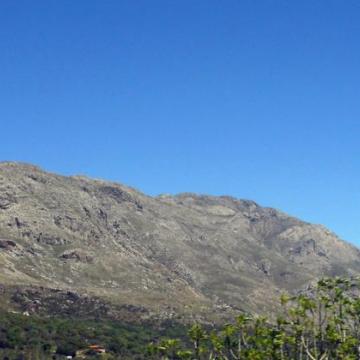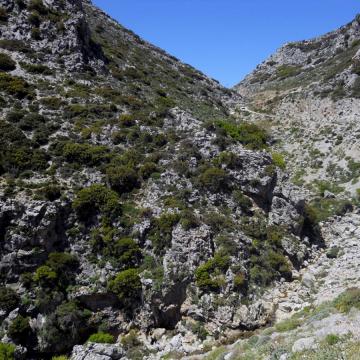GR4330002 - OROS KEDROS
Map
Quality
The ecological importance of the Kedros mountain, closely related to its geomorphological structure, lies mainly on the endemic or rare floristic elements (mostly chasmophytes) and on the ideal conditions its geological relief provides for big rapace nesting.Big rapaces, such as Gyps fulvus and Hieraaetus fasciatus nest on Kedros Mt., while there is evidence of the presence of the rare Gypaetus barbatus. Besides, the site is consodered an important Bird Area.Notable among the flora species are Dianthus pulviniformis, a legally protected (Presidential Decree 67/81) and rare species (IUCN 1993), found exclusively on Kedros Mt., and Cerastium brachypetalum ssp. doerfleri, an indeed very rare plant, also local endemic to Kedros. Actually, all the plant species listed on section 3.3 are Greek endemics with some degree of rarity.The endemic species Anthemis abrotanifolia, Crepis auriculifolia, Scabiosa albocincta, Hypericum kelleri, Prunella cretensis and Tulipa doerfleri are included in the IUCN Red Data Lists for Greece (1993), Europe (1988) and the World (1993) with the characterization "Rare" and are protected by the Greek Law (Presidential Decree 67/81).The site is also rich in endemic snail species, most of which are stenoendemics. All molluscan species cited on section 3.3, with the exception of Vitrea, Monacha, Pyramidula and Orculella which are Aegean endemics, are endemic to Crete or to W. Crete only.The reptiles Telescopus fallax pallidus, Chalcides ocellatus ocellatus, Natrix tessellata tessellata, Lacerta trilineata polylepidota, Columber gemonensis and the amphibians Bufo viridis viridis and Hyla arborea cretensis, permanently inhabit the Kedros massif and are protected by the Greek Law (Presidential Decree 67/81) and by the Bern convention (Annex II). Rana ridibunda is included in Annex III of the Bern convention.OTHER IMPORTANT SPECIES WITH MOTIVATION DExplanations are given in the above text.In addition:The following species are protected by the Greek Law (Presidential Decree 67/81) and are included in the IUCN Red Data List (1993) in the category of threatened plants: Cotoneaster nummularia (vulnerable), Anthemis abrotanifolia (rare), Tulipa doerfleri (rare).Arum creticum is a species with distribution in Crete and the East Aegean found only in SW. Turkey out of Greece. Viola rauliniana is a species with distribution in W. & C. Crete and Cyprus.
Other characteristics
The site is situated in the southwest of Psiloritis mountain (Idi), consisting exclusively of the massif of the mount Kedros; it comprises a cone delimited by the contour of 600 m with the highest summit (1776 m) almost in the middle. It is surrounded by a belt of 15 small villages, at the altitude range between 400 and 600 m, with no major settlements above the village zone. The geological substrate is limestone. The overall vegetation profile of the mountain can be described as short, dry scrubs and phrygana, with lack of tree forms. Canyons and rock cliffs are characteristic of the landscape and to a limited extend, there are naturally treeless slopes. There is an E4 mountain footpath, climbing up to the highest peak of the site.
Documentation
1) CORINE Information System. European Environment Agency. CORINE, Biotopes, 1991.
2) Patras University - Ministry of Environment, Physical Planning and Public Works. 1988. (Work Team: Economidou E. et al) Entopismos kai meleti ton ygroviotopon kai allon simantikon gia tin ornithopanida viotopon tis Kritis (Localization and study of wetlands and of other important for the birdfauna biotopes of Crete). Final report, Vol. 1, Patra. p. 384.
3) Hellenic Ornithological Society. 1994. Simantikes Periohes gia ta Poulia tis Elladas (Important Bird Areas in Greece).
4) Grimmet, R.F.A. & Jones, T.A. (Compilers) 1989 : Important Bird Areas in Europe. International Council of Bird Preservation (ICBP), Technical Publication No 9.
5) Kypriotakis, Z. Unpuplished data.
6) Legakis A. (Editor) 1995 . Apeiloumena, Prostateyomena kai Endimika eidi Zoon tis Elladas (Threatened, protected and endemic animal species of Greece). Zoological Museum, University of Athens, p. 35.
7) The red data book of threatened vertebrates of Greece. Hellenic Zoological Society Hellenic Ornithological Society. Athens 1992.
8) Turland N.J., Chilton L. & Press J.R. 1993. Flora of the Cretan area. The Natural History Museum, London : HMSO
9) Valakos, E. Unpuplished data.
10) Vardinoyannis K., 1994. Biogeografia ton cherseon malakion sto notio nisiotiko aigaiako toxo (Biogeography of land snails in the south Aegean arc). Ph.D. Thesis. Univerity of Athens.
11) Wettstein O. 1953. Herpetologia aegaea. Sber. oest. Akad. Wiss. math.naturw.Kl.Abt.l 162(910): 651833.
12) Georghiou K. 1995. Checklist of Endemic, Rare and Threatened Plants of Greece. Draft. University of Athens. (3.3, 3.4, 4.2)
13) Morgan V & C. Leon. 1992. Datasheets of Flora species for revision of Appendix I of the Bern Convention. Volume IV. endemic taxa of Cyprus, Greece and Turkey Nature and environment. Nature and Envrionment. No 63 p. 106. Council of Europe, Publishing and Documentaion Service, Strasbourg. (3.2.g.)
Reference: Natura 2000 data form, database release 7 Feb 2014





